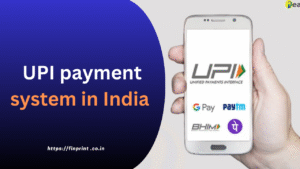Brief overview of the UPI payment system in India

The Unified Payments Interface (UPI) is a real-time payment system developed by the National Payments Corporation of India (NPCI). It enables instant fund transfers between different bank accounts using mobile devices. UPI has gained immense popularity in India since its launch in 2016, revolutionizing the way people make payments.
Importance of digital payment systems for seamless transactions
Digital payment systems, such as UPI, play a crucial role in facilitating seamless transactions in today’s digital age. They offer numerous advantages over traditional cash-based transactions. Some key benefits include:
- Convenience: Digital payment systems eliminate the need for physical cash and allow users to make transactions anytime, anywhere using their smartphones or other digital devices. This convenience has made them increasingly popular among individuals and businesses.
- Speed and efficiency: With digital payment systems, transactions can be completed in a matter of seconds or minutes, ensuring quick and efficient transfers of funds. This is especially important for businesses that require immediate payments or individuals who need to send money urgently.
- Security: Digital payment systems employ robust security measures, such as encryption and authentication protocols, to ensure the safety of transactions. This reduces the risks associated with carrying cash and provides users with a secure way to transfer funds.
- Financial inclusion: Digital payment systems have played a significant role in promoting financial inclusion by providing access to banking services for the unbanked and underbanked populations. UPI, for instance, has made it easier for individuals to open bank accounts and participate in the formal financial system.
- Transparency and accountability: Digital payment systems offer a traceable record of transactions, which enhances transparency and accountability. This is beneficial for businesses, as they can maintain accurate financial records, and for individuals, who can easily track their expenses and payment
Key Features and Functionality of India’s UPI System
Instant Fund Transfers between Bank Accounts
- UPI enables users to transfer funds instantly between bank accounts, eliminating the need for traditional methods like NEFT or RTGS.
- Users can initiate fund transfers by simply entering the recipient’s UPI ID, mobile number, or scanning a QR code.
Versatility for Various Transactions
- UPI supports a wide range of transactions, including peer-to-peer payments, merchant payments, bill payments, online shopping, and more.
- Users can make payments directly from their bank accounts using UPI, making it a convenient and secure mode of transaction.
Convenience of 24/7 Availability and Easy-to-Use Interface
- UPI services are available 24/7, allowing users to make transactions anytime, anywhere.
- UPI apps offer a user-friendly interface, making it easy for both tech-savvy and novice users to navigate and perform transactions.
Interoperability across Different Banks and Payment Service Providers
- UPI ensures interoperability, allowing users to transact across various banks and payment service providers seamlessly.
- Users can link multiple bank accounts to a single UPI ID, enabling them to choose the desired account for each transaction.
Unique UPI ID for Easy Identification
- Each user is assigned a unique UPI ID, which acts as an identifier for receiving payments.
- UPI IDs are in the format of “yourname@bankname,” making it simple for users to remember and share their payment details.
Secure Two-Factor Authentication
- UPI transactions incorporate two-factor authentication, ensuring enhanced security.
- Users are typically required to enter a UPI PIN or authenticate the transaction through biometrics, adding an extra layer of protection.
Seamless Integration with Mobile Wallets and Apps
- UPI can be linked to mobile wallets, allowing users to load money into the wallet through UPI and make payments seamlessly.
- Many popular apps and platforms have integrated UPI as a payment option, simplifying transactions within those ecosystems.
Transaction History and Notifications
- UPI provides users with a transaction history, allowing them to track their payments and view detailed transaction information.
- Users receive real-time notifications for successful transactions, ensuring transparency and keeping them informed.
QR Code-based Payments
- UPI supports QR code-based payments, enabling users to scan QR codes for quick and convenient transactions.
- Merchants can generate dynamic QR codes that users can scan to initiate payments without the need for manual entry.
Future Scope for Innovations and Services
- UPI continues to evolve, with new features and services being introduced regularly.
- Innovations such as UPI 2.0 have introduced enhancements like overdraft facility, invoice payments, and linking of overdraft accounts.
The key features and functionality of India’s UPI system make it a versatile, secure, and user-friendly platform for digital transactions. Its ease of use, 24/7 availability, and interoperability have contributed to its widespread adoption and popularity among Indian users.
Overview of Japan’s Interest in Joining India’s UPI Payment System
Japan’s decision to join India’s UPI payment system holds immense significance. By integrating with UPI, Japan aims to leverage the advanced digital payment infrastructure established by India. This strategic move reflects Japan’s interest in harnessing India’s expertise and experience in the digital payment sector. Additionally, this collaboration opens up a pathway for Japan to tap into India’s massive consumer market and explore opportunities for economic growth.
Statements from Japan’s Digital Minister
According to the statements made by Japan’s Digital Minister, this integration marks a major milestone in cross-border digital transactions. The Minister emphasized the importance of collaborating with India and acknowledged the potential benefits that this partnership brings. The integration will facilitate secure and efficient digital transactions between Japan and India, promoting economic cooperation and strengthening bilateral ties.
Japanese Digital Minister Kono Taro said that the government of Japan is seriously considering joining India’s UPI payment system.
Speaking with WION’s correspondent Sidhant Sibal, Minister Taro said, “Japan and India are trying to promote digital co-operation. We are serious about joining India’s UPI payment system and also contemplating how we can mutually recognise EID, starting with co-operation to increase interoperability. G7 agrees to establish a new framework with a new secretariat on cross-border data flow and we are hoping that the Indian government will join this framework.”
Talking about India’s digital revolution, the Japanese minister stated that he is surprised to see India leapfrogging in this sector. Taro stated that UPI is a “very convenient system of payment” which “can increase interoperability between governments”. “It could be another standard of cross-border payment,” reference by WOIN
Conclusion
Japan’s decision to join India’s UPI payment system marks a significant milestone in cross-border digital transactions. The integration signifies the growing importance of digital payment systems and the potential for collaboration between nations. This development opens up new avenues for economic cooperation, trade growth, and cultural exchange between Japan and India.
As Japan joins India’s UPI payment system, it sets the stage for increased collaboration and mutually beneficial partnerships. The seamless cross-border transactions enabled by this integration will promote economic growth and strengthen bilateral relations. With careful consideration of potential challenges, this collaboration has the potential to shape the future of digital payments and pave the way for enhanced trade and economic prosperity between Japan and India.



